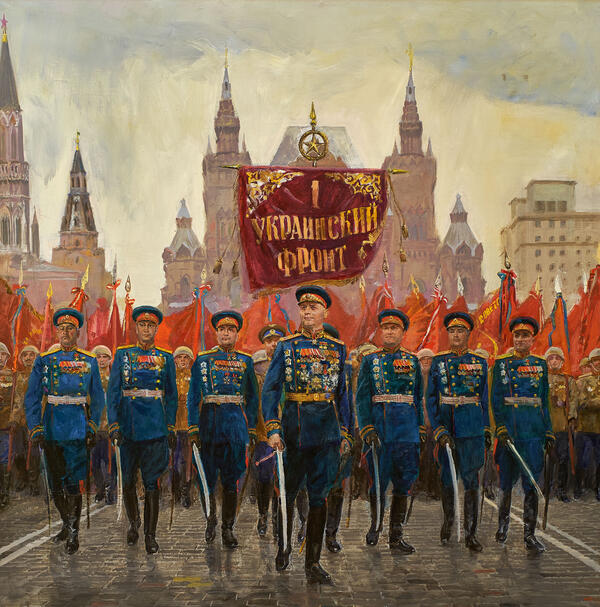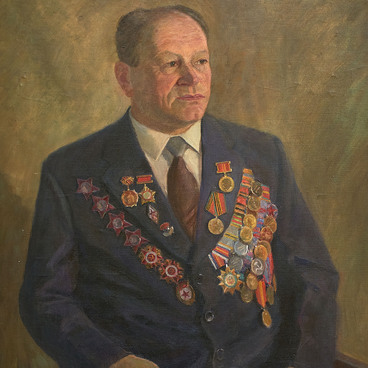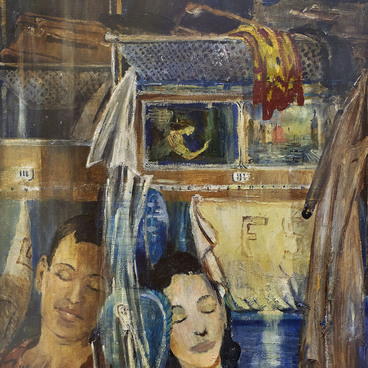The ‘Victory parade’ canvas from the collection of the Valuy Museums of History and Art was painted by the Soviet artist and author of monumental murals and still lifes Igor Radoman.
The artist was born on July 31, 1921, in Belarus. At the age of 23, he became a member of the Moscow Union of Artists, and in 1948 graduated with honors from the Surikov Art Institute in Moscow, where his teachers were famous painters Igor Grabar, Vladimir Favorsky and Alexandr Deyneka.
Igor Radoman created monumental murals of the Moscow metro, the railway station in Kharkiv, the Central house of aviation and cosmonautics, and other works. He designed Soviet pavilions at International exhibitions in Beijing and Leipzig and fulfilled state orders for historical and revolutionary paintings, and organized personal exhibitions in Moscow. Radoman’s works can be seen in the State Tretyakov Gallery, the State Historical Museum, the Museum of Arts of Uzbekistan, the Central Museum of the Great Patriotic War, and private collections. In 1982, the artist received the title of Honored Artist of the RSFSR.
Radoman’s ‘Victory Parade’ was transferred to the holdings of the Valuy Museum of History and Art in the 1990s from the All-Union Art Production Association named after Vuchetich of the Ministry of Culture of the USSR. This canvas, which has become a symbol of victory over the enemy, is striking in its solemnity. The artist captured a fragment of the parade on Red Square in Moscow on June 24, 1945. Under the red banner with the inscription ‘First Ukrainian Front’ is the military command. Until his death in 1944, the First Ukrainian front was commanded by General Nikolai Vatutin, who was born on the Valuy land. The General did not have to attend the Victory Parade; he did not walk on the cobblestones and did not see the fireworks. Descendants are proud to remember their famous countryman and honor his memory. In the picture, the first Ukrainian front is led by Marshal of the Soviet Union Ivan Konev, who took command of the front in May 1944.
The artist was born on July 31, 1921, in Belarus. At the age of 23, he became a member of the Moscow Union of Artists, and in 1948 graduated with honors from the Surikov Art Institute in Moscow, where his teachers were famous painters Igor Grabar, Vladimir Favorsky and Alexandr Deyneka.
Igor Radoman created monumental murals of the Moscow metro, the railway station in Kharkiv, the Central house of aviation and cosmonautics, and other works. He designed Soviet pavilions at International exhibitions in Beijing and Leipzig and fulfilled state orders for historical and revolutionary paintings, and organized personal exhibitions in Moscow. Radoman’s works can be seen in the State Tretyakov Gallery, the State Historical Museum, the Museum of Arts of Uzbekistan, the Central Museum of the Great Patriotic War, and private collections. In 1982, the artist received the title of Honored Artist of the RSFSR.
Radoman’s ‘Victory Parade’ was transferred to the holdings of the Valuy Museum of History and Art in the 1990s from the All-Union Art Production Association named after Vuchetich of the Ministry of Culture of the USSR. This canvas, which has become a symbol of victory over the enemy, is striking in its solemnity. The artist captured a fragment of the parade on Red Square in Moscow on June 24, 1945. Under the red banner with the inscription ‘First Ukrainian Front’ is the military command. Until his death in 1944, the First Ukrainian front was commanded by General Nikolai Vatutin, who was born on the Valuy land. The General did not have to attend the Victory Parade; he did not walk on the cobblestones and did not see the fireworks. Descendants are proud to remember their famous countryman and honor his memory. In the picture, the first Ukrainian front is led by Marshal of the Soviet Union Ivan Konev, who took command of the front in May 1944.



